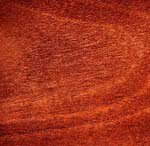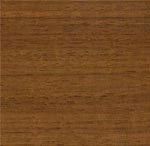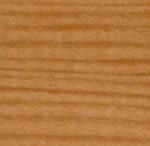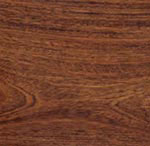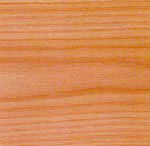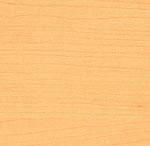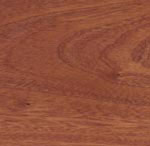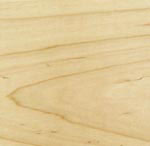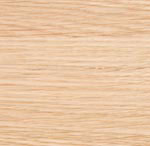Wood Types
Different woods are the palette of the furnituremaker. They provide color and texture, strength and beauty to handmade cabinetry.
Every wood has a distinctive grain structure. Woods such as white and red oak, ash and walnut have "open-pores". These woods have small holes in their surface that give the piece a textural quality. When a stain is applied to this type of surface, the stain tends to collect in the "open-pores" and appears darker than the rest of the piece. Tight grained woods include maple, alder, and cherry. These woods are smooth to the touch and can take finish evenly.
Each material has its own characteristics and advantages please contact our representative to help you choose which type will create the effect you desire.
At Pallas we make sure that only high quality and safe materials are used in the production of our custom kitchens and other wood cabinets.

African Mahogany
Appearance: The tree has a typical reddish-brown heartwood. The grain can be straight but is usually interlocked, producing a striped or roe figure on quartered surfaces.
Properties: The wood dries fairly rapidly with little degrade and is stable in use. The timber is of medium density and crushing strength, has low bending strength, very low stiffness and resistance to shock loads, and a very poor steam bending rate. Mahogany works easily with both hand and machine tools. Nailing is satisfactory; the wood glues well, and can be stained and polished to an excellent finish. The heartwood is moderately durable and the sapwood, liable to attack by powder post beetle, is resistant to impregnation.


American Walnut
Appearance: The attractive heartwood matures to a rich dark brown to purplish-black colour. It is usually straight-grained, but sometimes wavy or curly. Texture is rather coarse, but uniform.
Properties: The wood requires care in drying to avoid checking and degradation. There is small movement in service. Walnut is of medium density, bending and crushing strength, with low stiffness and shock resistance; it has good steam-bending rating. The timber works well with hand and machine tools, with a moderate blunting effect on cutting edges. It holds nails and screws well, and can be glued satisfactorily. It is a delight to work with, takes stain and polish with ease and can be brought to an excellent finish. Walnut is very durable. The sapwood is liable to attack by powder post beetle, the heartwood is resistant to preservative treatment and biodegradation, but the sapwood is permeable.


Cedar
Appearance: The sapwood is white, in contrast with the heartwood, which varies from dark chocolate brown in the centre to a salmon pink outer zone, which matures to a uniform reddish-brown. Once dry and exposed, the timber weathers to a silver grey, which makes it a particularly attractive prospect for shingles, weatherboard and timber buildings. The wood is non-resinous, straight-grained and with a prominent growth-ring figure. It has coarse texture and is rather brittle
Properties: Thin sizes dry readily, with little degrade, but thicker stock required careful drying. There is very small shrinkage in changing atmospheres, and stability in service. The wood has low strength in all categories and a very poor steam bending classification. It works easily with both hand and machine tools, with little dulling effect on tools. Cutters should be kept very sharp. It has fairly good nailing properties, but copper or galvanized nails should be used, as its acidic properties cause corrosion of metals and black stains in the wood in damp conditions. The wood can be glued easily and nailed satisfactorily, and takes stains of the finest tint without fading. It can be polished to an excellent finish. Sapwood is liable to attack by powder post beetle, the heartwood is durable and resistant to preservative treatment.


Cherry
Appearance: Cherry is a darker red-brown, with narrow brown pith flecks and small gum pockets. It has a straight grain and a fairly fine. Even texture.
Properties: The wood dries fairly rapidly, with a strong tendancy to warp and shrink and with medium movement in service. It has medium bending and crushing strengths and resistance to shock loads, low stiffness and very good steam bending rating. It works well with both hand and machines tools, with moderate blunting effect on cutting edges, but cross-grained timber tends to tear in planning. The wood holds screws and nails well, glues easily, and takes stain and polishes to an excellent finish. It is moderately durable; the sapwood is liable to attach by the common furniture beetle, but is almost immune to attack by powder post beetle. The heartwood is moderately durable and resistant to preservative treatment.


Douglas Fir
Appearance: The sapwood is lightly lighter in colour than the heartwood, which is a light reddish-brown. There is a prominent growth ring figure on plain-sawn surfaces or rotary cut veneers. Grain is mostly straight, but often wavy or spiral. Texture is medium and uniform.
Properties: The wood dries fairly rapidly and well without much warping, but knots tend to split and loosen. Resin canals also tend to exude and show as fine brown lines on longitudinal surfaces. Douglas fir is stable in service, has high bending strength, stiffness and crushing strength, medium resistance to shock loads and poor steam-bending rating. The wood works readily with both hand and machine tools. Cutters should be kept very sharp as there is a moderate blunting effect on tools. It is subject to beetle attack, is moderately durable and resistant to preservative treatment.


Pine (Yellow Pine)
Appearance: The sapwood is white and the heartwood varies form a light straw brown to a light reddish-brown. It is not very resinous; the ducts appear as thin brown lines on longitudinal surfaces but the growth rings are inconspicuous. It is straight grained and the texture is very fine and even.
Properties: The wood dries fairly rapidly and well, but sap stain should be avoided when air drying. Yellow pine has extremely low shrinkage and is very stable in service. The timber is weak in all strength properties, and is not suitable for steam bending. It works very easily with both hand and machine tools, has good screw and mail holding properties, glues well and be brought to excellent finish. It is susceptible to attack by the common furniture beetle. The heartwood is non-durable and resistant to preservative treatment, but the sapwood is permeable for treatment.


Poplar
Appearance: The heartwood, not clearly defined from the sapwood, varies from cream-white to very pale straw and in some species to pale brown or pink-brown. It is usually straight grained and rather woolly, but with a fine even texture.
Properties: The wood dries fairly rapidly and well with little degrade, and there is medium movement in service. It has low bending straight, very low stiffness and shock resistance, medium crushing strength and very poor steam-bending rating. It works easily with hand or machine tools, but very sharp and thin-edged cutters are required. Poplar holds screws and nails well and glues easily, but staining can be patchy. The wood will paint and varnish to satisfactory finish. Logs are liable to attach by beetles and wood-boring caterpillars. The sapwood, which constitutes a large portion of the tree, is perishable but permeable for preservation treatment.


Red oak
Appearance: The tree outwardly resembles a white oak, except that the heartwood varies from biscuit-pinkish to reddish-brown. The grain is usually straight; southern red oak is coarser textured than northern. Both species produce a less attractive figure than white oak due to the larger rays. There is considerable variation in the quality in red oak; northern red oak grows comparatively slower and compares favourably to white oak, while red oak form the southern states grow faster and produces a broader, heavier wood.
Properties: It dries slowly, and care is needed in air and kiln drying to prevent degrade. There is medium movement in service. The dense wood hs medium bending strength and stiffness, high shock resistance and crushing strength, and very good stem-bending classification. It usually offers a moderate blunting effect on cutters, which should be kept sharp. It requires pre-boring; gluing results are variable, but red oak takes stain well and polishes to a good finish. The wood is non- durable, moderately resistant to preservative treatment, and unsuited for exterior work.


Rock Maple
Appearance: The wood is creamy-white with a reddish-brown heart. It is usually straight-grained, but often curly or wavy, with fine brown lines marking the growth rings on plain-sawn surfaces. The texture is even, fine and lustrous. Pith flecks are sometimes present.
Properties: Rock maple dries fairly slowly with little degrade, and there is medium movement in service. The wood is of medium density, has good bending and crushing strengths, with low stiffness and shock resistance and a good stem-bending classification. It has a moderate blunting effect on tools, with a tendency to create tooth vibrations when sawing. Irregular grain tends to pick up when planning or moulding on quartered surfaces, and a reduced cutting angle is recommended. The wood has a tendency to ride on cutters and burn during endgrain working. Rock maple requires preboring for nailing, but it glues very well and polishes to an excellent finish. The wood is non-durable, liable to beetle attack, and subject to growth defects, now as pith flecks, caused by insects. The heartwood is resistant to preservation but the sapwood is permeable.


Sapele
Appearance: The narrow sapwood is pale yellow-white and the heartwood is salmon pink when freshly cut, maturing into reddish-brown. It has a closely interlocked grain, resulting in a pronounced and regular pencil striped or roe figure on quartered surfaces. Wavy grain yields a highly decorative fiddleback or mottled figure with a fine and even texture.
Properties: The wood dries fairly rapidly, with a marked tendency to distort. There is medium movement in service. Sapele has a medium density, bending and shock resistance, high crushing strength and low stiffness, and poor steam-bending rating. It works fairly well with both hand and machine tools, with moderate blunting of cutting edges caused by the interlocked grain. Nailing and gluing are satisfactory, and care is required when staining. When filled the surface can be brought to an excellent finish. The sapwood is liable to attack by powder post beetle and moderately resistant to impregnation. The heartwood is moderately durable but extremely resistant to preservative treatment.


Soft Maple
Appearance: The sapwood is indistinguishable for the heartwood, which is creamy-white in colour with a close, straight grain and indistinct growth rings on plain-sawn surfaces. The texture is even, fine and slightly less lustrous than rock maple and lighter in weight.
Properties: The wood dries rather slowly, with little degrade and there is medium movement in service. Soft maple is of medium density, with good bending and crushing strengths and low stiffness and shock resistance. It has a good steam-bending classification and works well with both hand and machine tools in all operations, as it offers a moderate blunting effect on tools. Nailing and screwing are satisfactory with care. Gluing is variable but it can be brought to a good finish. The wood is non- durable an moderately resistant to preservation treatment; the sapwood is liable to insect attack, but permeable.


Western Hemlock
Appearance: The hardwood is cream coloured with a very pale brown cast. Darker late-wood bands often produce a well-marked growth-ring figure with purplish lines. It is straight grained with afairly even texture, and is somewhat lustrous.
Properties: The initially high moisture content of the wood demands careful drying to avoid surface checking and ensure uniform drying in thick stock. Distortion is minimal. There is small movement in service. The wood has medium bending and crushing strength, low hardness and stiffness, and a moderate stem-bending rating. It works readily with both hand and machine tools with little dulling of cutting edges. It can be glued, stained, painted or varnished to a good finish. If should be pre-bored for nailing near the ends of dry boards. The sapwood of seasoned timber is liable to attack by the common furniture beetle. Dark brown of black resinous scars are also sometimes found, caused by fly larvae. The timber is non-durable or resistant to decay. The heartwood is resistant to preservative treatment.


White Oak
Appearance: The sapwood is lighter than the heartwood, which is light tan or yellow-brown, usually straight grained, but often irregular or cross-grained. It has a characteristic silver-grained figure on quartered surfaces because of braod rays and a moderately coarse texture.
Properties: The wood air dries very slowly with a tendency to split and check. These dense woods have high strength, low stiffness and resistance to shock loads, and a very good stem-bending rating. They are corrosive to metals, and liable to blue stain in damp conditions. Machining is generally satisfactory and they can be brought to an excellent finish. The wood is durable but liable to beetle attack; it is extremely resistant to preservative treatment thought the sapwood is permeable.








